| Srl | Item |
| 1 |
ID:
147027
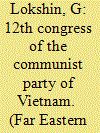

|
|
|
|
|
| Summary/Abstract |
On January 21-28, 2016, the 12th Congress of the ruling Communist Party of the Socialist Republic of Vietnam (CPV) took place in Hanoi. This important event in the public and political life of that country was the topic of a round-table discussion organized by the Center for Vietnam and ASEAN Studies at the Institute for Far Eastern Studies, Russian Academy of Sciences, held on February 25, 2016. About one hundred scholars of Vietnam and experts on Russian foreign policy, scholars from various research centers of Russia, deputies to the State Duma [parliament] of the Russian Federation, officials of the RF Foreign Ministry and other government agencies, representatives of the Eurasian Economic Commission, the Embassy of Vietnam to the RF, and Russia's Trade Mission in Vietnam, public organizations and business circles, Russian and Vietnamese mass media, and students and postgraduates of Moscow higher educational institutions attended the function.
|
|
|
|
|
|
|
|
|
|
|
|
|
|
|
|
| 2 |
ID:
147017
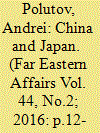

|
|
|
|
|
| Summary/Abstract |
This article examines the problem of the territorial dispute between China and Japan over the Senkaku/Diaoyudao Islands, along with the associated issues of developing oil and gas resources and the fishing industry in that region of the East China Sea, plus the military and political aspects of both sides' territorial claims.
|
|
|
|
|
|
|
|
|
|
|
|
|
|
|
|
| 3 |
ID:
147025


|
|
|
|
|
| Summary/Abstract |
China is the biggest foreign trade partner of ASEAN countries and the main donor to the development of regional infrastructure. The main trunk lines built with the help of Chinese investments in Southeast Asian countries will be linked up with important regional ports. This will make it possible to increase export cargo flows from the PRC to countries of ASEAN, the Middle East, and Africa.
|
|
|
|
|
|
|
|
|
|
|
|
|
|
|
|
| 4 |
ID:
147015
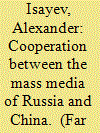

|
|
|
|
|
| Summary/Abstract |
This article presents a brief history of cooperation between the Russian and Chinese mass media over the last 25 years. The main directions, problems, and prospects of practical cooperation between the two countries' mass media are analyzed. The main emphasis is on widening the sphere of joint efforts in light of the nature of political and other relations between Russia and China.
|
|
|
|
|
|
|
|
|
|
|
|
|
|
|
|
| 5 |
ID:
147023


|
|
|
|
|
| Summary/Abstract |
The author singles out the key factors that have led to another profound crisis of the share market in China in 2015-2016. Apart from the slowing down of economic progress, pressure on the part of the currency market, and worsening of the general economic situation, the brant of responsibility for the crisis lies with the China Securities Regulatory Commission, which pursued a policy of excessive market incentives during the precrisis period.
|
|
|
|
|
|
|
|
|
|
|
|
|
|
|
|
| 6 |
ID:
147029


|
|
|
|
|
| Summary/Abstract |
The Great Geopolitical Revolution is the fourth book by Karen Brutents, the well-known political figure and authoritative political analyst of Soviet time. The author can be referred to the galaxy of honest and loyal to their ideals communists who were close to those who ruled the roost in the U.S.S.R., but at the same time, were not their blind followers, strove to give a sober assessment of the developments going on in the country, and prevent it from sliding down into a crisis. Karen Brutents adheres to this principled position now too, without ignoring the most pressing problems of our day in his publications. His rich political and managerial experience, broad contacts with outstanding intellectuals - scholars and statesmen - and brilliant journalistic style enable him to go deep into the problems tackled and elaborate his views on the future.
|
|
|
|
|
|
|
|
|
|
|
|
|
|
|
|
| 7 |
ID:
147020


|
|
|
|
|
| Summary/Abstract |
This article deals with the new military security policy of Japan after the return of the Liberal Democratic party to power in 2012. The author examines basic conceptual documents of Japan's strategy in this sphere. The analysis shows that Tokyo's course reflects a deviation from the traditional understanding of pacifism as the denial of the state's right to wage war.
|
|
|
|
|
|
|
|
|
|
|
|
|
|
|
|
| 8 |
ID:
147024


|
|
|
|
|
| Summary/Abstract |
The author discusses the functional and developmental problems of the oil and gas sector of China. He examines China's growing dependence on the import of energy resources as energy consumption grows. China may become the biggest energy consumer in the future, which opens broad prospects for such suppliers of raw hydrocarbon materials as Russia and Central Asian countries.
|
|
|
|
|
|
|
|
|
|
|
|
|
|
|
|
| 9 |
ID:
147021
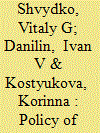

|
|
|
|
|
| Summary/Abstract |
The Japanese government considers the development of additive technologies as a key area of the country's science, technology, and innovation policy. This work attempts to analyze the policy of their development and identify the factors preventing even greater results from being achieved.
|
|
|
|
|
|
|
|
|
|
|
|
|
|
|
|
| 10 |
ID:
147026


|
|
|
|
|
| Summary/Abstract |
In January 2016, a new stage of reforming the command and control system of the armed forces began in China. This author examines redistribution of powers among the heads of the armed forces command and control system.
|
|
|
|
|
|
|
|
|
|
|
|
|
|
|
|
| 11 |
ID:
147028


|
|
|
|
|
| Summary/Abstract |
This article examines major aspects of the history of the Swedish East India Company, founded in Goteborg in 1731 to conduct trade with China and other Asian countries. Such interaction between China and Sweden influenced processes in the cultural, economic, and political spheres.
|
|
|
|
|
|
|
|
|
|
|
|
|
|
|
|
| 12 |
ID:
147019


|
|
|
|
|
| Summary/Abstract |
The author examines the Socialist Republic of Vietnam's approaches toward promoting cooperation with the United States in a variety of spheres and notes its active measures in cultivating collaboration with the aim of furthering the SRV's domestic and foreign interests. He believes that a key factor in the rapprochement between the two nations is China's policy in the Asia-Pacific Region (APR).
|
|
|
|
|
|
|
|
|
|
|
|
|
|
|
|
| 13 |
ID:
147022
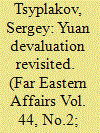

|
|
|
|
|
| Summary/Abstract |
This author continues to discuss the subject dealt with in last year's article titled Yuan Devaluation: Causes and Consequences. He examines the circumstances connected with China's further steps in reforming the yuan exchange rate - setting mechanism and yuan devaluation at the end of 2015-beginning of 2016.
|
|
|
|
|
|
|
|
|
|
|
|
|
|
|
|